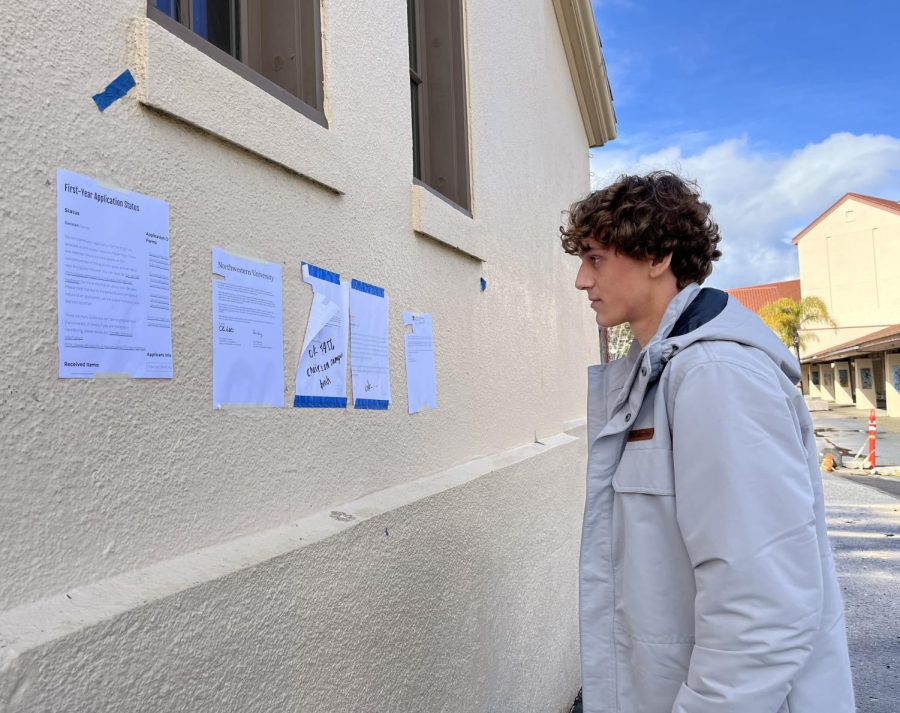Wall of Redirection replaces Wall of Rejection
Senior Felix Blanch looks at the Wall of Redirection after school on the side of the Haymarket Theatre. Following a compromise between Palo Alto High School administration and the Associated Student Body, the formerly named the Wall of Rejection was rebranded to endorse positivity and to encourage opportunities that can arise from rejection, according to Principal Brent Kline. According to ASB senior class president Ashley Hung, no matter the name, the wall is meant to embrace rejection and endure it together. “We’re probably all going to be rejected by colleges, and the wall serves as a message that rejection is normal and human,” Hung said. “It brings our class together through shared experiences and helps create a culture that although what we’re going through can be difficult in the moment, we’re all in this together.” (Photo: Leena Hussein)
February 22, 2023
Following a decision by Palo Alto High School Administration and the Associated Student Body, the unofficial Wall of Rejection is now rebranded as the Wall of Redirection.
The decision was made in hopes of lessening the toxic culture of college admissions for seniors, according to Principal Brent Kline.
An on-and-off tradition for at least 19 years, the Wall of Rejection has been a space on different parts of campus where seniors put up their college rejection letters. Currently, the wall is located on the side of the Haymarket Theatre.
Students can post rejection letters anonymously by removing their names or writing over them with markers.
According to a Feb. 7 Infocus segment featuring Kline, administrators initially decided to take down the Wall of Rejection in order to promote positivity instead of the negativity connoted with the word “rejection.”
Senior class president Ashley Hung said ASB wanted to bring the wall back.
“I didn’t put up the original wall, so initially I wasn’t heavily invested in it,” Hung said. “But after its removal and hearing our seniors’ desire to continue the tradition, my ASB peers and I decided to meet with Mr. Kline to compromise.”
Hung said Kline and ASB deliberated on the best solution to maintain the physical area while endorsing more positive values.
“The name was actually an idea from another senior,” Hung said. We realized that rather than being upset with the tradition as a whole, Mr. Kline and other administrators simply weren’t happy with the wording of the wall since ‘rejection’ can have a negative connotation.”
The former Wall of Rejection has been a tradition of controversy since its establishment in 2004. Since then, battles between administrators to reduce negativity on campus and students wanting to embrace rejection have been in play.
The Wall of Rejection did not make an appearance during the Spring of 2010 but returned in 2011 as the ‘colleges-missing-out wall’ in order to address admin’s concerns about encouraging positivity. The first attempt at renaming the wall did not last and the Rejection Wall was brought back in 2013. Throughout more recent years, editorials and opinion articles by The Paly Voice, Verde Magazine and The Campanile have urged admin to allow a rejection wall to promote the acceptance of failure.
According to Kline, the most recent decision to rename the wall was to encourage students to see the other paths that come out of rejection.
“[After] hearing the importance of why it [the tradition] was there, and how it affects students, we came to the idea of maintaining the wall but just changing the name,” Kline told The Paly Voice. “The reason behind it is once you get a letter of ‘thanks but no thanks’ or whatever you want to call it, it opens up avenues to new possibilities, and that’s why it remains just with a different name.”
Senior Alex Yan said he feels that renaming the wall takes away from the purpose of the Paly tradition.
“I am personally not a fan of it [renaming] because I think it [the Wall of Rejection] is a Paly tradition and it’s been like that for years and years,” Yan said. “I personally haven’t seen any students have a problem with rejection spreading negativity and increasing stress, and I’ve heard only good things about it and it makes me feel more like other classmates are also getting rejected.”
Yan said shying away from the word “rejection” is harmful as rejection is a normal part of life.
“[If ] only acceptances, everyone’s going to be like ‘Oh, everyone’s getting accepted and I’m getting rejected,’” Yan said. “It [the Wall of Rejection] just normalizes rejection and it tells you that it’s okay to be rejected because everyone else is getting rejected.”
Kline said he hopes the rebranded wall will help reduce the stigma surrounding college acceptances and difficulties that students go through during the admission process.
“After hearing the stories of students’ pressure, I’m all for eliminating as much stigma as I can as the principal of the school to change our thoughts and processes to more positive outcomes,” Kline said. “And that’s what I hope to be able to continue to do.”










![A protester in a chicken suit wearing a taco hat with the words “Cluck Trump” at the “No Kings” Democracy Fair in Palo Alto on Saturday. Protestor Mary Chan said she and her husband are horrified at the state of science and medicine in America. “What he [Trump] is doing by defunding scientific research is destroying our academic medical centers, and he’s [Trump] bankrupting rural medical centers,” Chan said. “We will have lasting negative impacts on American health for decades.”](https://palyvoice.com/wp-content/uploads/2025/10/11562FFE-9912-4152-BB01-582426B52ECB_1_105_c-225x300.jpeg)